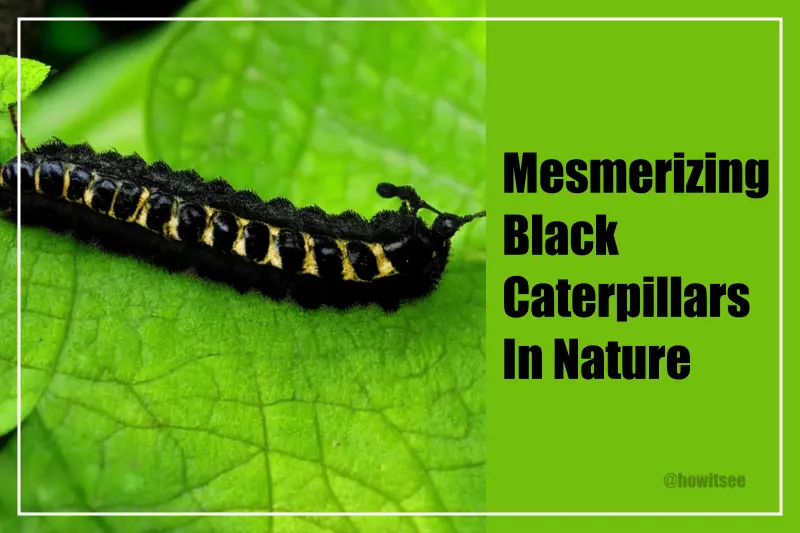In the vast tapestry of nature’s wonders, the realm of caterpillars offers a kaleidoscope of captivating colors and patterns. Among the diverse array of these enchanting creatures, the mesmerizing black caterpillars stand out with their striking beauty and intriguing characteristics.
From their velvety ebony exteriors to their delicate movements, these fifteen caterpillars showcase nature’s artistry at its finest. So let’s begin the article on, “14 Mesmerizing Black Caterpillars in Nature.”
14 Mesmerizing Black Caterpillars
1) Black Swallowtail Caterpillar
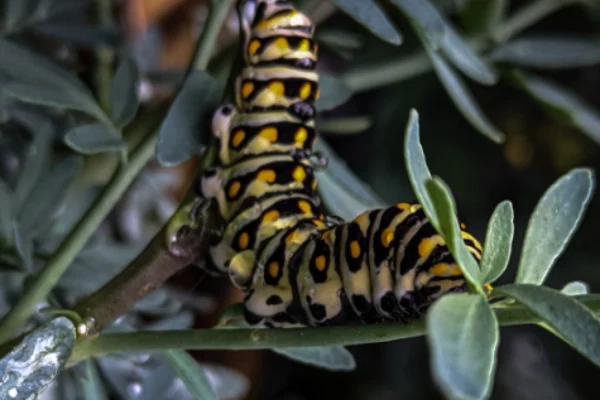
The Black Swallowtail Caterpillar (Papilio polyxenes) is a strikingly attractive bug. Its body is mostly black, with bright orange patterns and white dots. This caterpillar is well-known for its captivating beauty and varied patterns.
However, it molts multiple times as it develops, shedding its old skin and displaying a new, vivid coat beneath and going through a stunning transition, developing a chrysalis in which it metamorphoses.
It eventually transforms into a gorgeous black butterfly with delicate yellow and blue patterns, captivating viewers with its grace and beauty. The Black Swallowtail Caterpillar exemplifies the beauty and awe of nature’s life cycles.
2) Walnut Caterpillar
The Walnut Caterpillar, also known by its scientific name Datana integerrima, is unique among caterpillars due to a number of intriguing traits. This caterpillar is distinguished by its colorful look.
Its remarkable and distinctive appearance is made up of a black body with yellow stripes and tufts of black spines. Potential predators are warned by this unusual color that the animal is hazardous or unpalatable.
The main food sources for the walnut caterpillar, whose diet is extremely specialized, are the leaves of hickory and walnut trees. Farmers and lovers of walnut trees are concerned about it because of the defoliation that can result from its eating habits.
The spines of the walnut caterpillar can irritate the skin if handled or touched; however, they are not very hazardous. Being cautious is crucial while communicating with them.
3) Eastern Tent Caterpillar

An interesting bug with a distinctive look is the Eastern Tent Caterpillar (Malacosoma americanum). The majority of its body is black, with eye-catching white and blue patterns.
But this caterpillar is renowned for the way it congregates with other caterpillars in giant silk tents built on trees. As a food source for birds and other predators, the eastern tent caterpillar is crucial to the environment.
4) Peacock Butterfly Caterpillar
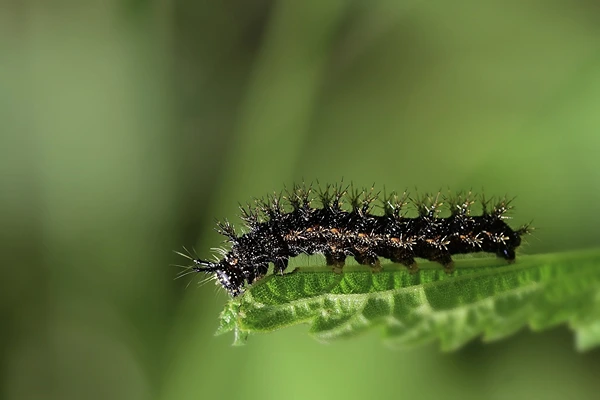
Scientifically named Inachis io, the Peacock Butterfly caterpillar is an intriguing organism with a number of distinctive traits. The appearance of eye-like markings on its back, which resemble the vivid patterns on the adult Peacock Butterfly’s wings, is one of its most notable characteristics.
By terrifying prospective predators and drawing their attention away from the caterpillar’s fragile body, these eye patches act as a type of protective mimicry.
This caterpillar’s prickly bristles, which shield it from predators and discourage it from attacking, are another remarkable feature.
As the Peacock Butterfly caterpillar matures, it also goes through a series of molts, during which it sheds its skin and develops a new, bright look.
Its capacity to change from a small, newly-hatched caterpillar into a gorgeous butterfly displays the fascinating marvels of metamorphosis.
The Peacock Butterfly caterpillar is a wonderful example of the exquisite beauty and survival techniques found in the natural world thanks to its beautiful patterns and distinctive adaptations.
5) Gypsy Moth Caterpillar

Lymantria dispar, a noteworthy insect with a distinctive look, is the caterpillar of the gipsy moth. Its caterpillar has a black body with long, bristly hairs covering it. The hairs let the caterpillar thrive in varied conditions and protect it from predators.
The Gypsy Moth Caterpillar, however, is regarded as an invasive species and may seriously harm forests by defoliating trees.
It consumes a variety of host plants, such as pines, birches, and oaks. Despite its destructive propensity, the Gypsy Moth Caterpillar is a fascinating subject to study due to its distinctive look and influence on forest ecosystems.
6) Black Witch Moth Caterpillar
The Black Witch Moth Caterpillar (Ascalapha odorata) is an unusual-looking critter. The body is black with spiky orange and white projections.
The Black Witch Moth Caterpillar is the larval stage of the Black Witch Moth, which is one of the world’s biggest moth species. The mature moth is beautiful, with black wings and exquisite markings.
The Black Witch Moth, despite its name, has nothing to do with witchcraft or supernatural beliefs. Instead, it is a magnificent illustration of natural variety.
7) Black Cutworm Caterpillar
The Black Cutworm Caterpillar (Agrotis ipsilon) is a fascinating insect with a basic look. It has a sleek black body. This caterpillar is well-known for its eating habits as well as its agricultural influence.
While the Black Cutworm Caterpillars are not harmful to people, it is considered an agricultural nuisance since they can cause crop damage.
Its unusual black appearance and eating habits pique the curiosity and worry of farmers and researchers.
8) Woolly Bear Caterpillar
The Woolly Bear caterpillar, Pyrrharctia isabella in scientific jargon, is a fascinating insect with a unique collection of traits. This caterpillar is distinguished by its distinctive color, which includes black bands at either end of its body and an orange-reddish band in the center.
This eye-catching pattern acts as a warning coloration, letting predators know that the Woolly Bear caterpillar could have chemical defenses in place.
The fact that this caterpillar can endure subfreezing temperatures is another remarkable feature. Its amazing capacity to manufacture cryoprotectants—substances that stop ice from forming within the body—allows it to survive harsh winter weather.
Folklore holds that the Woolly Bear caterpillar can foretell weather patterns because of the width of its black bands, which is thought to be a good indicator of how harsh winter would be.
The Woolly Bear caterpillar is a symbol of the flexibility and durability of nature’s wonders because of its extraordinary adaptations and distinctive look.
9) Black Blotched Leopard Moth Caterpillar
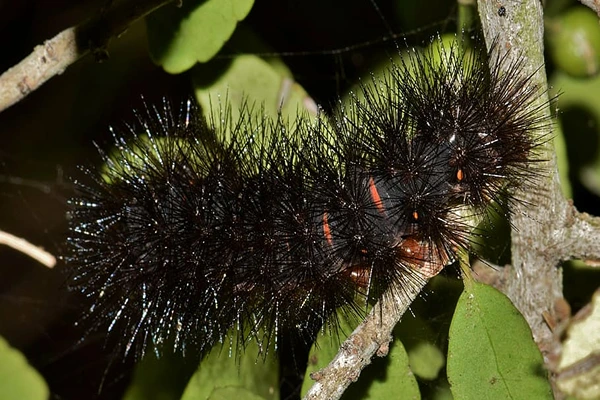
Zeuzera pyrina, the caterpillar of the Black Blotched Leopard Moth, is an alluring bug with a distinctive look. It has a black body with white stripes and white speckles.
The contrast between the white and yellow patterns and the black hue results in a visually arresting and attention-grabbing show.
Despite not being toxic to people, the bristles and hairs of the Black Blotched Leopard Moth Caterpillar should not be directly touched since they may irritate the skin or trigger allergic reactions.
This caterpillar’s transformation reveals its distinctive and detailed look, making it an interesting topic to see in the wild.
10) Garden Tiger Moth Caterpillar
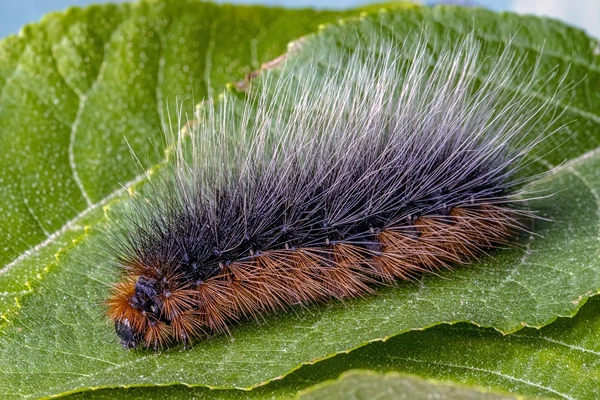
The plump, cylindrical body of the Garden Tiger Moth Caterpillar is coated in thick, long bristles or hairs. The caterpillar’s color varies, but it usually has a black or dark brown background with orange or yellow stripes running across its segments.
These bands are embellished with clusters of black spines, resulting in a distinctive and distinct visual pattern.
The Garden Tiger Moth Caterpillar’s protective mechanism is another remarkable trait. It has the capacity to retract its head and show a vivid red or orange “warning” color on its thoracic segments when threatened.
This color serves as a visual barrier to prospective predators, indicating that the caterpillar is either unappealing or has chemical defenses.
11) Azalea Caterpillar

The Azalea Caterpillar (Datana major) stands out among caterpillars thanks to a number of distinctive characteristics. Its colorful appearance is one of its most distinctive features.
The Azalea Caterpillar has a yellow-green body covered in unique black dots, and its back is lined with a row of sharp black spines.
Potential predators are warned by this color that the caterpillar could be armed with poisons or chemical defenses. It mostly consumes azalea leaves as well as those of other woody plants like willow. Due to its specialized diet, it is highly adapted to its surroundings and fills a specific ecological niche.
The Azalea Caterpillar’s spines, however, should not be handled or touched since they may irritate the skin. Avoiding close contact with this caterpillar is advised to avoid any possible allergic reactions or discomfort.
12) Mourning Cloak Caterpillar
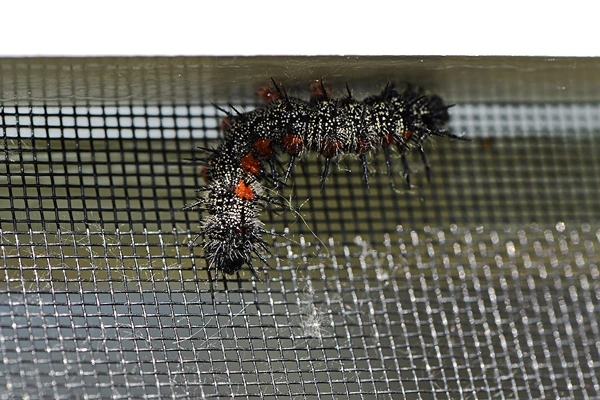
The Mourning Cloak Rows of red-orange markings run along the sides of the caterpillar’s long, spiky black body. Dark hue and vivid dots contrast sharply to produce an arresting visual presentation.
The color of this caterpillar acts as a warning to prospective predators that it can be poisonous or unpleasant.
The Mourning Cloak Caterpillar’s capacity for hibernation is yet another distinctive quality. The Mourning Cloak Caterpillar can go into a condition of diapause, unlike many other caterpillars that pupate right away after reaching adulthood.
It searches for sheltered spots like tree crevices or leaf litter during this time, where it will hibernate there throughout winter. The caterpillar can live in colder areas because of its modification.
13) Scarce Dagger Moth Caterpillar
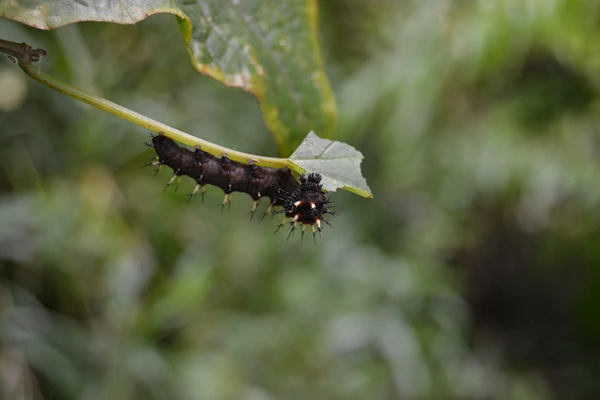
The body of the Scarce dagger moth caterpillar is plump and coated in short, thick hairs. The caterpillar’s base color can range from light green to yellow, and it is ornamented with distinctive black spines and tufts of longer hairs with black tips.
The caterpillar can blend in with the flora well, thanks to the contrast of colors and textures.
The defense mechanism of the Scarce Dagger Moth Caterpillar is distinctive. It is known to take a protective stance when threatened by curling its body and pulling back its head while exhibiting the vivid orange or yellow stripes on its flanks.
Potential predators are warned away by the caterpillar’s striking colors, which might be chemical defenses or poisons.
14) Red Admiral Caterpillar
The body of the Red Admiral Caterpillar is black and covered with small, branching spines, giving it a rough and spiky look. The body of the caterpillar is decorated with colorful patterns of yellow and white dots or stripes, providing a visually appealing show.
The Red Admiral Caterpillar’s affinity with certain host plants is another distinguishing trait. It predominantly feeds on nettle species, particularly stinging nettles, which are its primary food source. This diet specialization demonstrates the caterpillar’s adaption to feed on certain plants.
The Red Admiral Caterpillar molts multiple times as it feeds and develops, losing its skin and expanding further. It eventually develops into a chrysalis and metamorphoses into an adult Red Admiral butterfly.
Conclusion
Now, we have come to an end of the 14 Mesmerizing Black Caterpillars found in nature and have discussed several parameters such as their size, location, danger level, color, and unique characteristics.
Also Read:

I am a person who effortlessly combines creativity, hard work, and a strong interest in nature. My writing takes you on incredible journeys where science and imagination come together. I am driven by a deep curiosity to understand the wonders of life, and dive into the details of biology with thorough research and a genuine appreciation for nature. My articles are full of vivid descriptions and fascinating facts, making the world of biology come alive. Whether I am writing articles, essays, or fiction, my work sparks curiosity and shows the incredible beauty of our natural world.
